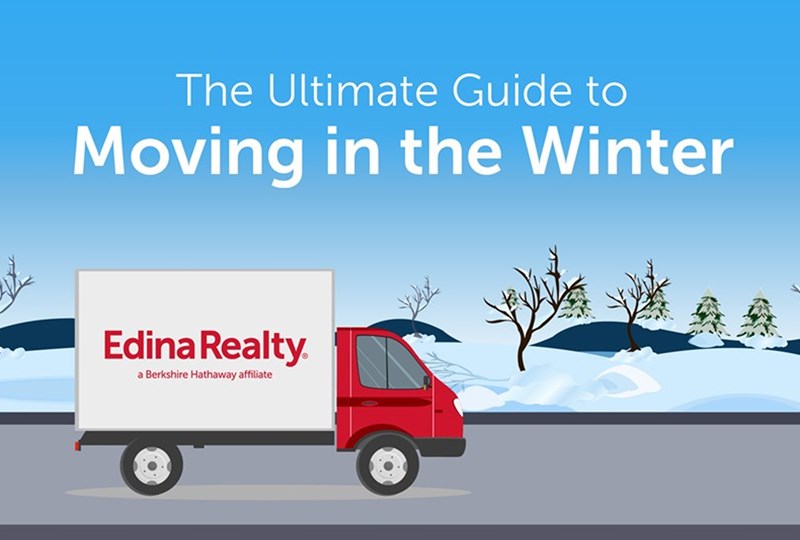
Key insights:
- Check out your vehicle and road conditions before you begin packing and driving.
- The way you pack your belongings is important. Think about color-coding boxes for a hassle-free move.
- Don’t forget to savor the moment! Take a minute to appreciate your previous space and embrace your new home.
Whether you’re moving long-distance or down the street, moving during the winter presents a unique set of challenges and considerations. Be sure to follow these 12 tips as you pack up your home and prepare to move into a new property this winter.

1. Prep your vehicles
Start with your car or moving truck, making sure that the tires, brakes and battery are in good condition. You’ll also want to check and fill all fluids.
If you’re moving long-distance and don’t already have roadside assistance, consider purchasing it. This service will keep you covered should your vehicle break down on the trek to your new house. And, if you plan to drive the moving truck yourself, ask the rental company if they provide any kind of emergency assistance.
Finally, create an emergency car kit that includes bottled water, non-perishable snacks, blankets, a windshield scraper, a flashlight, sand or salt and some road flares to deploy if your car breaks down on the side of the road. Don’t skip this step! Not only is this kit perfect for a winter move, it’s also smart to keep in your car all winter long.
2. Flip the “on” switch at your new home
Before you hop in the car to drive to your new home, you’ll want to ensure that the property is ready for move-in. Transfer all utilities into your name in advance, so they are on and functioning a day or two before your move, if possible. The days are shorter, darker and colder during the winter, so it’s extra important that the lights and heat are working as you settle in.
3. Color-code your boxes
While packing for your new home, be intentional. Color-coding your move is a great way to stay organized. With color-coded boxes, you can be sure that everything ends up in the right place for unpacking, saving you time and frustration.
4. Bring extra clothes
If you’re moving or relocating to Minnesota or western Wisconsin, wear warm, climate-appropriate items. Dress yourself in layers and clothes that are easy to remove as you change temperatures throughout the day. If possible, avoid wearing hoodies or other clothing with strings, which may catch on doorways or the moving truck.
As for outerwear, wear a pair of boots with good traction to avoid slipping on icy or slushy ground. You’ll also want to keep a hat or earmuffs handy throughout the day and find gloves with gripping power so you don’t drop boxes or heavy furniture.
On the other hand, if you’re moving somewhere warmer, pack a spare set of clothes to change into when you arrive in your new climate.
5. Get care for your kids and pets
As much as you want to share this family moment, you may want to hire a babysitter for move-in day if you have younger children. With childcare, you can give your undivided attention to the moving process and minimize any accidents involving big boxes and small kiddos.
Moving with pets may pose a different challenge. While unloading boxes, the last thing you want to think about is if Rex is running across the road or tracking snow into your new home. To prevent this, think about sending your pets to a boarding service or a friend’s house for the duration of your move.
6. Assemble a moving team
Enlisting the help of a moving team — professional or not — will prove to be extremely helpful as you transfer your life from one property to the next.
To thank the group of people helping your family move, have water, soda, coffee or hot cocoa on hand. Then, once you arrive at your new home, order pizza from a highly-rated local place. Your first meal in your new home will be stress-free and delicious. (Mention you’re new to the area while placing your order and you may even get a discount!)
If you hire a professional moving crew, they may expect a tip instead of a pizza dinner. Consumer Affairs recommends a standard tip of $50 per person for an eight-hour day, or $20 per person for four hours. If the move is especially tricky, consider tipping 20%.
7. Check road conditions early and often
Be sure to visit and bookmark your state’s Department of Transportation website for travel advisories and updates on road conditions. Here are the sites for Minnesota and Wisconsin. If you’re moving outside our area, you can find your state’s DOT website here. Be prepared with a backup plan in case road conditions change suddenly or become unsafe.
8. Start early in the day
On moving day, leave early and be prepared to arrive late. Always allow for more time than you think you’ll need. If you’re moving locally, it’s smart to get started very early in the day so you don’t have to move in icy conditions after the sun has gone down. If you’re moving across state lines, be sure to add in an extra travel day in case you unexpectedly need to pull off and stay in a hotel overnight.
9. Keep sidewalks and driveway clear
Whatever you do, don’t pack away the shovels! As you move in and out of a new home you’ll need to keep your sidewalks and driveways clear so your moving crew can enter and exit safely. Even if you have a heated driveway, keep an extra bag of sand or salt handy and apply it liberally to any slippery walkways.
10. Maintain a clean and dry home
You can’t expect your moving crew to remove their heavy winter boots every time they come in and out, but you can protect your floors or carpet by lining your home with flat cardboard. If you’re moving to another wintry area, don’t forget to purchase cardboard (or a few extra moving boxes) for both ends of your move.
Keeping a handful of towels near the entry and exit doorways and in the moving truck will also help keep your home and items dry. You can use the towels to wipe down the dolly or wet boxes as they come in and out of the house.
Finally, cover items if it’s snowing or wet outside. Wrap anything from furniture to large TVs in plastic wrap to protect them from the harsh winter climate.
11. Create a system
As you leave your old residence, ask the crew to exit through the garage and enter through the front door. By designating this system for entrance and exit, you’ll minimize collisions and allow the outgoing furniture and boxes to stay covered in the garage if the moving truck is occupied with another set of helpers.
When moving into your new home, reverse this process. Movers should bring furniture or boxes in through the garage and exit through the front door. If any furniture is too wet to bring in, you can leave it in the garage for a few hours or longer to dry off before bringing it inside.
12. Savor the moment
Moving can be extraordinarily draining, so be sure to take a deep breath as you leave your old home for the new. While the day may have been snowy and stressful, you won’t regret taking a moment to say goodbye as you enter the next phase of your life. You may even want to snap a few photos to document the day (and your new home).
Are you ready to take the next step in your home move? Reach out to Edina Realty or one of our agents to get started.










 Equal Housing Lender | Prosperity Home Mortgage, LLC may operate as Prosperity Home Mortgage, LLC dba Edina Realty Mortgage in Minnesota and Wisconsin. ©2024 Prosperity Home Mortgage, LLC dba Edina Realty Mortgage. (877) 275-1762. 3060 Williams Drive, Suite 600, Fairfax, VA 22031. All first mortgage products are provided by Prosperity Home Mortgage, LLC. Not all mortgage products may be available in all areas. Not all borrowers will qualify. NMLS ID #75164 (For licensing information go to: NMLS Consumer Access at http://www.nmlsconsumeraccess.org/) Licensed by the Department of Financial Protection and Innovation under the California Residential Mortgage Lending Act. Licensed by the Delaware State Bank Commissioner. Georgia Residential Mortgage Licensee. Massachusetts Mortgage Lender and Mortgage Broker MC75164. Licensed by the NJ Department of Banking and Insurance. Licensed Mortgage Banker-NYS Department of Financial Services. Rhode Island Licensed Lender. Rhode Island Licensed Loan Broker. Rhode Island Licensed Third-Party Loan Servicer. Also licensed in AK, AL, AR, AZ, CO, CT, DC, FL, ID, IL, IN, KS, KY, LA, MD, ME, MI, MN, MO, MS, MT, NC, ND, NE, NH, NM, NV, OH, OK, OR, PA, SC, SD, TN, TX, UT, VA, VT, WA, WI, WV and WY.
Equal Housing Lender | Prosperity Home Mortgage, LLC may operate as Prosperity Home Mortgage, LLC dba Edina Realty Mortgage in Minnesota and Wisconsin. ©2024 Prosperity Home Mortgage, LLC dba Edina Realty Mortgage. (877) 275-1762. 3060 Williams Drive, Suite 600, Fairfax, VA 22031. All first mortgage products are provided by Prosperity Home Mortgage, LLC. Not all mortgage products may be available in all areas. Not all borrowers will qualify. NMLS ID #75164 (For licensing information go to: NMLS Consumer Access at http://www.nmlsconsumeraccess.org/) Licensed by the Department of Financial Protection and Innovation under the California Residential Mortgage Lending Act. Licensed by the Delaware State Bank Commissioner. Georgia Residential Mortgage Licensee. Massachusetts Mortgage Lender and Mortgage Broker MC75164. Licensed by the NJ Department of Banking and Insurance. Licensed Mortgage Banker-NYS Department of Financial Services. Rhode Island Licensed Lender. Rhode Island Licensed Loan Broker. Rhode Island Licensed Third-Party Loan Servicer. Also licensed in AK, AL, AR, AZ, CO, CT, DC, FL, ID, IL, IN, KS, KY, LA, MD, ME, MI, MN, MO, MS, MT, NC, ND, NE, NH, NM, NV, OH, OK, OR, PA, SC, SD, TN, TX, UT, VA, VT, WA, WI, WV and WY.